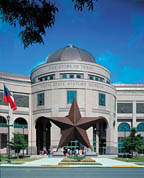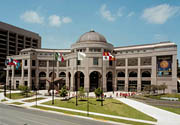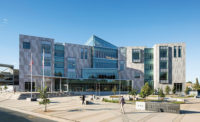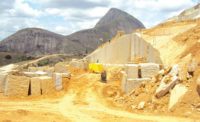
The Bob Bullock Texas State History Museum in Austin, TX, was modeled after the nearby Texas State Capitol building, which reflects Renaissance Revival-style architecture of the late 19th century. The architects at E. Verner Johnson and Associates, Inc. in Boston, MA, worked in association with HKS, Inc. in Dallas, TX, to capture a similar look for this museum with the use of Sunset Red and Carnelian granite. "The building is just blocks away from the Texas State Capitol building, so we wanted to relate to this building and architecturally complement it," said Project Architect Brad Nederhoff of E. Verner Johnson and Associates, Inc. Moreover, the Sunset Red granite is native to the state, as it is quarried in Marble Falls, TX.
The exterior of the entry rotunda to the 180,000-square-foot museum is inscribed with 30-inch-tall letters that read: "The Story of Texas" and "Texas State History Museum." The building is almost entirely clad in the locally quarried Sunset Red granite - the same material employed for The Texas State Capitol Building. Random-sized pieces of the stone - some as large as 9 feet long and 6 feet wide - were installed for the exterior. The Sunset Red granite was also used as paving for the courtyard plaza and for parts of the dining deck on the second floor.
To contrast the Sunset Red granite, Carnelian granite was employed for the base of the building as well as for the accent band on both its interior and exterior. This darker colored granite was chosen to complement the lighter "salmon" color of the Sunset Red granite, according to the architect. The small rock-faced Carnelian granite pieces ranged in size from 2 to 4 feet in length.
According to the architect, these two types of granite were combined and finished in a number of ways to create different effects in the color and texture of the stone. "Rather than make the building with one stone or one texture, we wanted to have a richer palette of color and texture within these two types of granite," said Nederhoff. "There were about five different shades created from these two stones." The Sunset Red granite was thermal and honed finished, and the Carnelian granite was jet honed and polished.
The curvaceous design of the building posed a challenge during construction, according to the architect. Unlike a building with just one flat surface, the Texas State History Museum has many different planes, with some areas set back further from the surface than other areas. Calculating the geometry of the building and fitting the stone together to form the curved exterior required great skill and precision, according to Nederhoff. "It is a tightly constrained site that slopes over 20 feet from one side to the other," he said. "It was a complex building for the contractors to build." In addition, each piece of stone had to be precisely sized before being installed.
Overall, designing this project came with a unique set of requirements. "This project was very specialized and required a lot of coordination with the exhibits and special theatres," said Nederhoff. "Our company specializes in designing museums - we have worked on over 140 museums - but this was one of the most complex projects. HKS, our associated architect, did a terrific job of detailing and documenting the granite work."
The challenging aspects of the design were echoed by Kevin Becnel of Intrepid Enterprises in Harvey, LA, the installer for the project. Because the granite facing was radial cut, it was difficult interfacing the stone with the masonry block units. "It was difficult to set the stone," said Becnel, who explained that it took a lot of trial and error to set the stone properly. The stone installed for the building's exterior was mechanically anchored.
Also, the quick timeframe for the project presented another difficulty for the installers, he explained. "Time was the main issue," said Becnel. "We were supposed to start installation around June, but due to construction issues we had to wait until August, which shortened our duration."
According to Nederhoff, additional work required the masons to dig out solid limestone for the two levels of parking space below the building. A special machine saw was used to cut the edges of the material and hollow it out, so concrete could be poured into it. "They used special equipment to cut a very straight edge in the stone," explained Nederhoff. "Then they had to dig out the rock, a process which took nearly 6 to 7 months to complete."
Approximately 70 masons worked on the both the interior and exterior of the building, which was fabricated at once. The installation process began in August 2000 and concluded in March of 2001. Work on the entire project took one full year to complete.
Interior stonework
Although most of the stone was employed for the building's facade, smaller pieces of various sizes were also used to accent parts of the museum's interior, including the column covers, railings, staircase, walls and the lobby floor.The grand lobby floor features a silhouette of the state of Texas, which is made of polished Radiant Red granite and is inlayed in a terrazzo field with a Carnelian granite border. The design has a breadth of approximately 50 feet. Another unique floor design is found in the rotunda, which features a colorful 40-foot-diameter terrazzo design depicting a campfire scene with themes of Texas' past.
The stone for the interior walls was installed with copper wire and plaster, and the granite and terrazzo flooring was set in sand and Portland cement, according to Becnel.
A signature element in the four-story rotunda is a large stone staircase, which was built in an elegant spiral design. With Carnelian granite employed for the steps and Sunset Red granite for the sides, the staircase demonstrates how both types of granite complement one other.
In total, 80,000 square feet of both stones were used for the entire exterior of the museum, with an additional 20,000 square feet used for the interior. Small quantities of limestone were also used within the queuing area of the IMAXR theatre and in the dining area.

Building a dream
The realization of the Texas State Museum completes a mission that began in 1996, when former Lieutenant Governor Bob Bullock shared his dream for a state history museum to be built in Austin, TX. This dream became a reality on April 21, 2001, the same date of the 165th anniversary of the battle of San Jucinto.The museum is topped with a copper dome and overlooks a plaza that features native plants and a 35-foot bronze star. It includes three floors of state-of-the-art exhibits and 17 different media and interactive experiences that trace Texas history from before European exploration to recent times. A temporary exhibit gallery on the first floor features short-term exhibits on topics and themes related to Texas and its history. The museum also boasts Austin's only IMAXR Theatre, with 2-D and 3-D capabilities, as well as a multimedia special effects Texas Spirit Theater - the only one of its kind in Texas. Other museum amenities include a 200-seat indoor/outdoor caf?a Texas Fair-theme Store and classrooms, in addition to the underground parking garage that can accommodate 476 vehicles.
Bullock died in 1999 at the age of 69 before his dream project was completed. A bronze statue of Bullock was made in his honor, which is located in the second floor lobby of the museum. A limestone wall behind the statute is engraved with his trademark words, "God Bless Texas."
End Box
The Bob Bullock Texas State History Museum, Austin, TX
Owner: State of Texas, State Preservation Board
Architect: E. Verner Johnson and Associates Inc., Boston, MA, in association with HKS, Inc., Dallas, TX
General Contractor: Constructors and Associates, Austin, TX
Construction Manager: Thos. S. Byrne, Fort Worth, TX
Stone Installer: Intrepid Enterprises, Harvey, LA
Stone Quarrier/Fabricator: Cold Spring Granite Co., Marble Falls, TX (quarry location)/ Cold Spring, MN (headquarters)
Stone Supplier: Leander Cut Stone, Cypress Hill, TX (Limestone)

